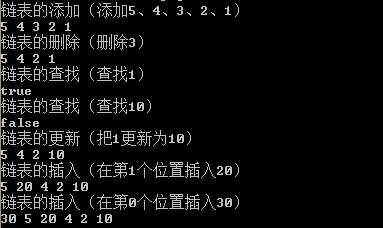Java描述数据结构之链表的增删改查
Posted tosser
tags:
篇首语:本文由小常识网(cha138.com)小编为大家整理,主要介绍了Java描述数据结构之链表的增删改查相关的知识,希望对你有一定的参考价值。
链表是一种常见的基础数据结构,它是一种线性表,但在内存中它并不是顺序存储的,它是以链式进行存储的,每一个节点里存放的是下一个节点的“指针”。在Java中的数据分为引用数据类型和基础数据类型,在Java中不存在指针的概念,但是对于链表而言的指针,指的就是引用数据类型的地址。
链表和数组都是线性的数据结构,对于数组而言其长度是固定的,由于在内存中其是连续的,因此更适合做查找与遍历,而链表在内存中是并不是顺序存储的,但是由于其是通过“指针”构成的,因此在插入、删除时比较数组更为的方便。
下面的代码通过内部类并结合递归的方式来实现了一个简单的用Java语言描述的链表的数据结构。
首先来看一下,链表数据结构的定义,代码如下:
1 class NodeManager { 2 private Node root; // 根节点 3 private int currentIndex = 0; // 节点的序号,每次操作从0开始 4 5 public void add(int data) {} 6 public void delNode(int data) {} 7 8 public void print() {} 9 10 public boolean findNode(int data) {} 11 12 public boolean updateNode(int oldData, int newData) {} 13 14 // 向索引之前插入 15 public void insert(int index, int data) {} 16 17 // 谁拥有数据,谁提供方法 18 class Node { 19 private int data; 20 private Node next; // 把当前类型作为属性 21 22 public Node(int data) { 23 this.data = data; 24 } 25 26 public void setData(int data) { 27 this.data = data; 28 } 29 30 public int getData() { 31 return data; 32 } 33 34 // 添加节点 35 public void addNode(int data) {} 36 37 // 删除节点 38 public void delNode(int data) {} 39 40 // 输出所有节点 41 public void printNode() {} 42 43 // 查找节点是否存在 44 public boolean findNode(int data) {} 45 46 // 修改节点 47 public boolean updateNode(int oldData, int newData) {} 48 49 // 插入节点 50 public void insertNode(int index, int data) {} 51 } 52 }
对于链表的定义来说,NodeManager类是用来管理链表操作的,而成员内部类Node是用于提供链表数据与链式结构的。对于类的使用者来说,并不直接访问数据,因此操作的是NodeManager类,而内部类Node提供了真正的数据管理,因此Node类需要提供真正的数据操作方法,对于NodeManager类中也需要提供一套由外部来操作链表的方法。因此,在NodeManager类和Node类中都提供了看似相同的方法,但实际的意义并不相同。
下面来查看NodeManager类和Node类中的add()方法,代码如下:
1 public void add(int data) { 2 if ( root == null ) { 3 root = new Node(data); 4 } else { 5 root.addNode(data); 6 } 7 } 8 9 // 添加节点 10 public void addNode(int data) { 11 if ( this.next == null ) { 12 this.next = new Node(data); 13 } else { 14 this.next.addNode(data); 15 } 16 }
代码中上面的方法是NodeManager类中的方法,而下面的方法是Node类中的方法。
在Manager类中提供了一个root的成员变量,它用于管理链表的头节点,因此在添加节点时,会先判断root是否为空,如果为空则直接将节点由root来进行保存,如果root不为空,则通过Node类中的addNode()方法来进行添加,添加到思路是找到当前链表的最后一个节点,并将新添加到节点赋值给最后一个节点的next成员变量中。
对于链表的其他操作也是相同的思路,关于链表增删改查和输出的完整代码如下:
1 class NodeManager { 2 private Node root; // 根节点 3 private int currentIndex = 0; // 节点的序号,每次操作从0开始 4 5 public void add(int data) { 6 if ( root == null ) { 7 root = new Node(data); 8 } else { 9 root.addNode(data); 10 } 11 } 12 public void delNode(int data) { 13 if ( root == null ) return ; 14 if ( root.getData() == data ) { 15 Node tmp = root; 16 root = root.next; 17 tmp = null; 18 } else { 19 root.delNode(data); 20 } 21 } 22 23 public void print() { 24 if ( root != null ) { 25 System.out.print(root.getData() + " "); 26 root.printNode(); 27 System.out.println(); 28 } 29 } 30 31 public boolean findNode(int data) { 32 if ( root == null ) return false; 33 if ( root.getData() == data ) { 34 return true; 35 } else { 36 return root.findNode(data); 37 } 38 } 39 40 public boolean updateNode(int oldData, int newData) { 41 if ( root == null ) return false; 42 if ( root.getData() == oldData ) { 43 root.setData(newData); 44 return true; 45 } else { 46 return root.updateNode(oldData, newData); 47 } 48 } 49 50 // 向索引之前插入 51 public void insert(int index, int data) { 52 if ( index < 0 ) return ; 53 currentIndex = 0; 54 if ( index == currentIndex ) { 55 Node newNode = new Node(data); 56 newNode.next = root; 57 root = newNode; 58 } else { 59 root.insertNode(index, data); 60 } 61 } 62 63 // 谁拥有数据,谁提供方法 64 class Node { 65 private int data; 66 private Node next; // 把当前类型作为属性 67 68 public Node(int data) { 69 this.data = data; 70 } 71 72 public void setData(int data) { 73 this.data = data; 74 } 75 76 public int getData() { 77 return data; 78 } 79 80 // 添加节点 81 public void addNode(int data) { 82 if ( this.next == null ) { 83 this.next = new Node(data); 84 } else { 85 this.next.addNode(data); 86 } 87 } 88 89 // 删除节点 90 public void delNode(int data) { 91 if ( this.next != null ) { 92 if ( this.next.getData() == data ) { 93 Node tmp = this.next; 94 this.next = this.next.next; 95 tmp = null; 96 } else { 97 this.next.delNode(data); 98 } 99 } 100 } 101 102 // 输出所有节点 103 public void printNode() { 104 if ( this.next != null ) { 105 System.out.print(this.next.getData() + " "); 106 this.next.printNode(); 107 } 108 } 109 110 // 查找节点是否存在 111 public boolean findNode(int data) { 112 if ( this.next != null ) { 113 if ( this.next.getData() == data ) { 114 return true; 115 } else { 116 return this.next.findNode(data); 117 } 118 } 119 120 return false; 121 } 122 123 // 修改节点 124 public boolean updateNode(int oldData, int newData) { 125 if ( this.next != null ) { 126 if ( this.next.getData() == oldData ) { 127 this.next.setData(newData); 128 return true; 129 } else { 130 return this.next.updateNode(oldData, newData); 131 } 132 } 133 return false; 134 } 135 136 // 插入节点 137 public void insertNode(int index, int data) { 138 currentIndex ++; 139 if ( index == currentIndex ) { 140 Node newNode = new Node(data); 141 newNode.next = this.next; 142 this.next = newNode; 143 } else { 144 this.next.insertNode(index, data); 145 } 146 } 147 } 148 }
以上就是链表基本操作的完整代码,下面写一个调用的代码进行测试,代码如下:
1 public class LinkList { 2 public static void main(String[] args) { 3 NodeManager nm = new NodeManager(); 4 System.out.println("链表的添加(添加5、4、3、2、1)"); 5 nm.add(5); 6 nm.add(4); 7 nm.add(3); 8 nm.add(2); 9 nm.add(1); 10 nm.print(); 11 System.out.println("链表的删除(删除3)"); 12 nm.delNode(3); 13 nm.print(); 14 System.out.println("链表的查找(查找1)"); 15 System.out.println(nm.findNode(1)); 16 System.out.println("链表的查找(查找10)"); 17 System.out.println(nm.findNode(10)); 18 System.out.println("链表的更新(把1更新为10)"); 19 nm.updateNode(1, 10); 20 nm.print(); 21 System.out.println("链表的插入(在第1个位置插入20)"); 22 nm.insert(1, 20); 23 nm.print(); 24 System.out.println("链表的插入(在第0个位置插入30)"); 25 nm.insert(0, 30); 26 nm.print(); 27 } 28 }
将代码编译、运行,结果如下图:

对于Java中的集合类中用到了不少的数据结构的知识,等自己状态好的时候学习学习Java集合类的源码。我会努力做一个初级程序员!
以上是关于Java描述数据结构之链表的增删改查的主要内容,如果未能解决你的问题,请参考以下文章